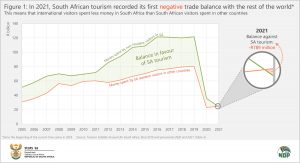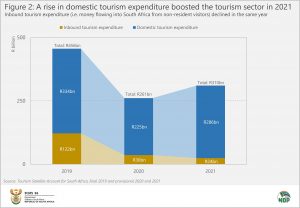South Africa’s tourism trade balance entered negative territory in 2021
International visitors to South Africa bring much-needed foreign exchange. Dollars, euros and pounds are converted to rands and spent on tourism products like food, accommodation, recreation and transport. This helps drive domestic tourism-related activities within the country.
There is often a lot of attention on the amount of money that non-resident visitors, comprising both tourists and same-day visitors, bring into the country. However, there is less attention on the inverse: money that South African residents take out of the country as they travel abroad. The difference between these two is referred to as South Africa’s tourism trade balance with the rest of the world.
South Africa records its first negative tourism trade balance
The first Tourism Satellite Account for South Africa report was released in 2009, covering data for the reference year 2005. According to consecutive releases of the report, South Africa benefited from a positive tourism trade balance with the rest of the world from 2005 to 2020. A positive tourism trade balance indicates that more money was spent on inbound tourism in South Africa by non-resident visitors than on outbound tourism, where South African residents spend money abroad.
Figure 1 shows inbound tourism expenditure (the green line) and outbound tourism expenditure (the orange line) from 2005 to 2021. The shaded area between the two represents the tourism trade balance, which reached its largest positive value in 2016. That year, non-resident visitors to South Africa spent R121 billion within the borders of the country and South African resident visitors spent R75 billion abroad, resulting in a positive tourism trade balance of R46 billion. In 2019, the balance was R41 billion.
The COVID-19 pandemic in 2020 and 2021 hit international travel hard, resulting in a significant drop in tourism-related spending across the board. Despite the fall in both inbound and outbound tourism expenditure in 2020, South Africa’s tourism trade balance with the rest of the world was still positive.
In 2021, however, the tourism trade balance turned negative for the first time since the start of the time series in 2005. Inbound tourism expenditure continued to erode in 2021, led by a further decline in the number of international visitors. In 2019, 14,8 million non-resident visitors graced our shores, shrinking to 3,9 million in 2020 and 2,7 million in 2021. As inbound tourism expenditure weakened, outbound tourism expenditure increased in 2021.
Domestic tourism to the rescue
While there was less spending from non-resident visitors in 2021, domestic tourism trips and expenditure strengthened, keeping South Africa’s tourism sector afloat. Internal tourism expenditure (which refers to total tourism spending in the country by both non-resident visitors and domestic visitors) increased from R261 billion in 2020 to R310 billion in 2021. This was driven by domestic visitors. Domestic tourism expenditure increased to R286 billion in 2021, recovering to 86% of its 2019 pre-pandemic level of R334 billion (Figure 2).
This is in line with Stats SA data that show an increase in domestic travel by South African residents. The number of domestic same-day trips undertaken by household heads increased from 12 million in 2020 to 16 million in 2021. The number of domestic overnight trips increased from 7 million to 11 million over the same period.1
Other results from the latest Tourism Satellite Account for South Africa statistical report
- The tourism sector directly contributed 2,3% to South African GDP in 2021, an increase from 2020’s contribution of 2,1% but still significantly lower than 2019’s contribution of 3,7%. In 2021, the tourism sector’s contribution was about the same as the construction industry.
- The tourism sector directly employed 492 561 individuals in 2021, an increase from the 454 114 individuals directly employed in 2020, but still far below the 777 686 individuals directly employed in 2019. The number of direct tourism sector jobs in 2021 comprised 3,4% of the total South African labour force.
- In 2021, almost four in ten tourism sector jobs were in the road passenger transportation industry, while almost two in every ten tourism sector jobs were in the food and beverages serving industry.
For more information, download the Tourism Satellite Account for South Africa, final 2019 and provisional 2020 and 2021 statistical report here.
1 Statistics South Africa, Domestic Tourism Survey, 2021. Table 2a (download here).
Similar articles are available on the Stats SA website and can be accessed here.
For a monthly overview of economic indicators and infographics, catch the latest edition of the Stats Biz newsletter here.



